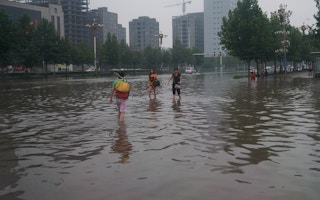It is a little-known fact among general public and politicians that floods cause more damages each year globally than any other form of natural disasters. According to the United Nations, over the 20-year period between 1995 and 2015, 157,000 people died due to floods and another 2.3 billion were affected.
Currently, global average annual flood losses are estimated at $104 billion. The country incurring the highest losses is China, followed by US and India. These losses do not include disruptions to global supply chains when industries located in flood plains are often affected by floods.
The 2011 flood in Thailand first brought this problem to global attention. However, the country which has the potential to disrupt the global supply chains the most because of floods is China, followed by Brazil, Russia and India.
Because of topography, high population, urbanization and tremendous economic growth during the past decades, China has had three of the 10 most costly global floods since 1950. Equally, because of population density, all the three Chinese floods resulted in high fatalities compared to the other seven floods elsewhere where deaths were in hundreds.
At global number two is the July-August flood of 1998, which resulted in 3,656 deaths and an economic loss of $43.7 billion in 2014. The sixth costly global flood was also in China, during July-August 2010. It caused 829 deaths and losses of 31.1 billion in 2014. In the 10th place is the flood of June-July 1996 which caused 2,775 deaths and an economic damage of $19 billion in 2014.
Flooding has been a perennial problem in China. Earlier one of the important tests of good rulers was their ability to protect the citizens from the ravages of floods. This requirement continues even today.
The good news is that death toll from floods in China has steadily declined due to government actions such as construction of dams, dikes and levees, early warning systems and prompt evacuation measures. The bad news is, economic costs of floods are steadily increasing and are likely to rise in foreseeable future.
It appears that the 2016 floods are likely to enter in Chinese record books as one of the most severe ones. The floods season is not yet over. Damages incurred are already significant. This is primarily because rainfall in China this year has been 21 per cent higher than average. In Yangtze Basin, it has been 27 per cent higher than average.
Yangtze is the longest river of China and the third-longest in the world. It is also the most important water artery in terms of economy and development. Thus, a serious Yangtze flood has major implications not only for China but also for the world by disrupting manufacturing and transportation links as well as the global supply chain.
According to the Office of State Flood Control and Drought Relief Headquarters, as of July 3, 32 million people in 26 provinces have been affected, 186 have died, 26 are missing, and 1.4 million people have been relocated. Some 73,000 homes have collapsed and crops have been lost in 700,000 ha.
Direct economic losses already exceed $10 billion. Flood season does not end until August.
The severe flood this year was not unexpected. Vice-Premier Wang Yang had warned in June that El Niño this year was likely to increase flooding risks significantly in Yangtze and Huai basins. In 1998, another El Niño year, the death toll reached 3,556. With better preparedness, human losses this year are likely to be significantly less.
“
Flooding has been a perennial problem in China. Earlier one of the important tests of good rulers was their ability to protect the citizens from the ravages of floods. This requirement continues even today.
In terms of national policies, flooding was recognized to be a major problem during the post-1995 period when each of the two floods in 1996 and 1998 caused several thousand deaths and billions of dollars on economic damages.
While floods became a serious concern, the solutions then proposed went only part way to solve the problem. This main policy was to construct large dams which could effectively store flood waters. After the flood seasons, stored excess water could be used during months of no, or limited, rainfall to generate hydroelectricity and then used for agriculture, industrial and domestic purposes.
Major dams like Three Gorges were constructed, having flood control as an important objective.
There is absolutely no doubt that had the Three Gorges and other dams not been constructed, flood damages in China during high rainfalls years, including this year, would have been significantly higher.
Paradoxically, in the Chinese social media, major dams have been accused of contributing to high flood damages. Nothing is further from truth. Well designed and managed, large dams invariably ameliorate floods damages. They do not add to them.
Storage dams, however, are not enough. When high rainfalls occur over the Chinese cities, they currently do not have adequate infrastructure to drain away excess waters. Cities have grown much faster than drainage works could be planned, executed and managed.
Consequently, the number of cities that are seriously affected by floods has more than doubled during the past 7-8 years. At present, routinely more than 200 Chinese cities are waterlogged each year during each monsoon season.
Breakneck expansions of major cities, poor planning, endemic corruption and absence of good land use planning, have further exacerbated the problem.
Take Wuhan, capital of Hubei province at the confluence of Yangtze and Han rivers. It is historically known as the “city of 100 lakes”. However, it has lost more than 2/3rd of its lakes,from 127 to 40, during the period 1949-2015.
Lakes and wetlands were filled to make way for construction projects. These lakes and wetlands used to store water during the flood years, reducing adverse impacts on the city. The 40 remaining lakes are not enough of a buffer to store flood waters.
Furthermore, their storage capacities have been impaired by heavy sedimentation due to poor land use practices and construction activities.
“
Paradoxically, in the Chinese social media, major dams have been accused of contributing to high flood damages. Nothing is further from truth. Well designed and managed, large dams invariably ameliorate floods damages.
Corruption and wasteful spending have further aggravated flood problems in China for decades. For example, Premier Zhu Rongji coined a phrase to describe a badly constructed crumbling dike in Jiujiang City in 1998 as a tofu-dregs and turtle egg project. Tofu dregs are pieces left over after making tofu.
The situation still has not improved that much. According to local media reports, the person responsible for the construction of 1 billion RMB drainage project in Wuhan was accused of accepting 1.6 million RMB bribes between 2005 and 2013.
Bad planning and shenanigans have ensured that Wuhan’s subway line built only four years ago was badly inundated. People’s Daily reported last month that Wuhan allocated RMB 13 billion, in 2013, for a three-year programme to improve its drainage. Only RMB 4 billion has been disbursed so far, and completion date has now been delayed to 2018.
National Development and Reform Commission noted on July 10 that fruits and vegetables prices in some flooded areas have “risen significantly”. They instructed local authorities to “closely monitor prices”. Flooding is likely to increase annual consumer prices by 0.2 per cent, to over 2 per cent.
It would also have a negative impact on China´s GDP growth in the third quarter. Equally, construction and rebuilding activities may increase aggregate demand. Thus growth in the fourth quarter, after a weak July-August period, likely be higher.
Chinese leadership is well aware of the economic and social risks imposed by floods. Premier Li Keqiang has already noted, the “government is better prepared than ever”. It has taken several measures and is fully prepared againstpossible floods since July-August are “key periods for floods”. Similarly, President Xi Jinping has ordered array of measures to step up relief actions.
China has made considerable progress in recent decades to reduce fatalities due to floods. However, a new mindset is needed at all levels of decision-making, central, provincial and municipal. It has to be realized that improper developments can contribute to floods, and floods do affect development. Policy-makers need to realize that floods are both developmental issues and humanitarian concerns.
There are systemic problems that need to be overcome. Water bodies and wetlands in and around cities have been filled up for construction activities, thus have seriously disrupted natural drainage patterns. Lakes, as in Wuhan, have steadily been shrinking.
Governments at provincial and municipal levels have mostly turned blind eyes to construction activities in flood-prone areas. Cities have not kept up with the construction and proper operation and maintenance of storm drainage systems. Dikes protecting the cities may be working but drainage systems in many cities are grossly inadequate.
Technically and economically, floods in China cannot be completely eliminated. However, their impacts can be significantly reduced by proper land use planning and flood management. For the Chinese leaders at all levels, floods are a challenge that needs to be overcome to deliver good living conditions for the society.
Finally, many poor decisions taken over the past 50 years on urban development cannot be eliminated overnight. It will take political will, time, money, and good holistic planning and implementation before flood damages in China can be significantly reduced.
Asit K. Biswas is Distinguished Visiting Professor at Lee Kuan Yew School of Public Policy, National University of Singapore; Cecilia Tortajada is Senior Research Fellow at the Institute of Water Policy, in the same School. This article was republished from China Daily with permission from the authors.









